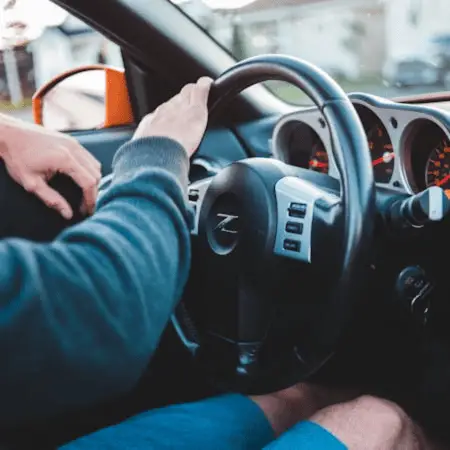You are here to find out the answer to the question “Is It Safe To Drive Without Power Steering”, In this article I will give you a detailed answer to this question. So keep on reading…
Power steering is a vital component in modern vehicles that assists drivers in steering their cars with ease. It utilizes hydraulic or electric mechanisms to amplify the force applied to the steering wheel, making it easier to turn the vehicle, especially at low speeds.
The primary function of power steering is to reduce the amount of effort required by the driver to steer the vehicle, particularly when maneuvering through tight spaces or making sharp turns. This is achieved by utilizing hydraulic pressure or electric assistance to augment the steering input provided by the driver.
Power steering enhances vehicle control and maneuverability, improving the overall driving experience. It allows drivers to navigate with precision, reduces driver fatigue, and enhances safety on the road by ensuring swift and accurate responses to steering inputs.

Is It Safe to Drive Without Power Steering?
Driving without power steering can be safe under certain conditions, but it largely depends on factors such as the driver’s experience, road conditions, and the vehicle’s design. However, it generally poses challenges due to the increased effort required to steer, potentially leading to muscle strain and reduced control, especially in emergency situations. While experienced drivers may manage, it is to ensure safety for both the driver and others on the road.
Impact on Vehicle Handling:
Without power steering, the mechanical connection between the steering wheel and the wheels becomes more direct. This means that the driver must exert more force to turn the steering wheel, particularly when the vehicle is moving slowly or when attempting to maneuver in tight spaces.
As a result, the steering response becomes less fluid and more labor-intensive. This can compromise the driver’s ability to maintain precise control over the vehicle, especially in situations that require quick adjustments, such as avoiding obstacles or navigating sharp corners.
The increased effort required to steer without power assistance can also lead to delayed reactions, making it more challenging to execute timely maneuvers in emergency situations.
Physical Strain on the Driver:
Driving without power steering places significant physical demands on the driver’s muscles, particularly those of the arms, shoulders, and upper body.
Unlike power-assisted steering systems, where hydraulic or electric mechanisms assist in turning the wheels, manual steering requires the driver to generate all the necessary force to maneuver the vehicle.
This increased exertion can lead to muscle fatigue, discomfort, and even strain-related injuries, especially during prolonged periods of driving. As the driver’s muscles tire from the continuous effort required to turn the steering wheel, their ability to maintain optimal control over the vehicle may diminish.
This can compromise their reaction times and overall driving performance, posing safety risks not only to themselves but also to other road users. The physical strain experienced by the driver can detract from their overall driving experience, leading to discomfort and reduced enjoyment behind the wheel.

challenges of driving without power steering:
Increased Effort:
Without the assistance of power steering, the driver must exert significantly more physical effort to turn the steering wheel, particularly when the vehicle is stationary or moving at low speeds.
This increased effort can be particularly taxing on the driver’s muscles, especially during long drives or in situations where frequent steering adjustments are required, such as navigating through congested traffic.
Maneuverability:
The absence of power steering can significantly affect the maneuverability of the vehicle, especially in tight spaces or when attempting to make sharp turns.
Maneuvering without power assistance requires the driver to apply greater force to the steering wheel, making it more challenging to negotiate bends or navigate through narrow streets and parking lots.
This limitation in maneuverability can potentially increase the risk of collisions with obstacles or other vehicles, particularly in crowded urban environments.
Emergency Situations:
In emergency scenarios where quick and precise steering is crucial, the lack of power steering can pose significant challenges.
Sudden obstacles or the need for evasive maneuvers require swift and accurate steering inputs to avoid collisions or hazards. However, without power assistance, the driver may struggle to turn the steering wheel rapidly enough to navigate around obstacles or change direction effectively.
This delay in responsiveness can increase the likelihood of accidents or reduce the driver’s ability to safely navigate hazardous road conditions.

helpful tips for driving without power steering
Here are some helpful tips for driving without power steering:
Maintain a Firm Grip: Grip the steering wheel firmly with both hands to maintain control over the vehicle, especially when exerting more force to steer. A secure grip can help you manage the increased resistance of manual steering more effectively and reduce the risk of losing control.
Anticipate Turns and Maneuvers: Plan and anticipate upcoming turns or maneuvers to minimize the need for sudden, sharp steering inputs. By predicting your actions in advance, you can approach corners and obstacles with smoother, more gradual steering movements, reducing the strain on your muscles and enhancing overall control.
Use Proper Body Positioning: Position yourself comfortably behind the wheel with your back straight and shoulders relaxed. This posture helps optimize leverage and allows you to exert force more efficiently when steering. Avoid slouching or leaning too far forward, as this can limit your range of motion and make steering more challenging.
Reduce Speed in Tight Spaces: Slow down when navigating through tight spaces or making sharp turns, as these maneuvers require more effort to steer without power assistance. By reducing your speed, you give yourself more time to react and maneuver the vehicle smoothly, reducing the strain on your muscles and enhancing safety.
Increase Following Distance: Leave extra space between your vehicle and others on the road to account for the reduced maneuverability of manual steering. Maintaining a safe following distance gives you more time and space to react to changes in traffic conditions and helps mitigate the risk of rear-end collisions or other accidents.
Perform Regular Maintenance: Ensure that your vehicle’s steering system is in good condition by performing regular maintenance checks. Keep an eye on components such as the steering linkage, tie rods, and steering gearbox to detect any signs of wear or damage early on. Proper maintenance helps ensure optimal steering performance and reduces the likelihood of unexpected failures while driving.
By following these tips, you can navigate safely and confidently without power steering, minimizing the challenges associated with manual steering and enhancing your overall driving experience.
You May Find Helpful
- 6 Reasons: Why Learners Fail Their Driving Test
- Is Driving Hard For Beginners? A Complete Guide
- Battery Voltage Drops While Driving – Causes & What To Do
- How To Start A Car With A Bad Crankshaft Sensor?
Conclusion
While it’s technically possible to drive without power steering, it’s generally not recommended for safety reasons. The increased effort and reduced control can make driving more challenging and potentially hazardous, especially in demanding situations. If your vehicle’s power steering fails, exercise caution and consider seeking professional assistance to ensure your safety and that of others on the road.
